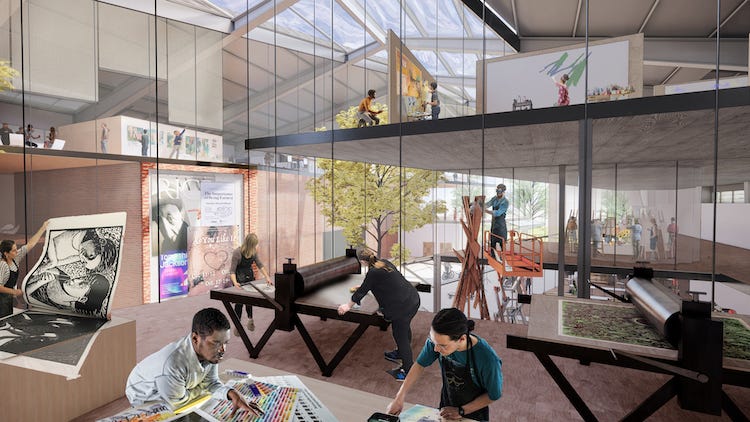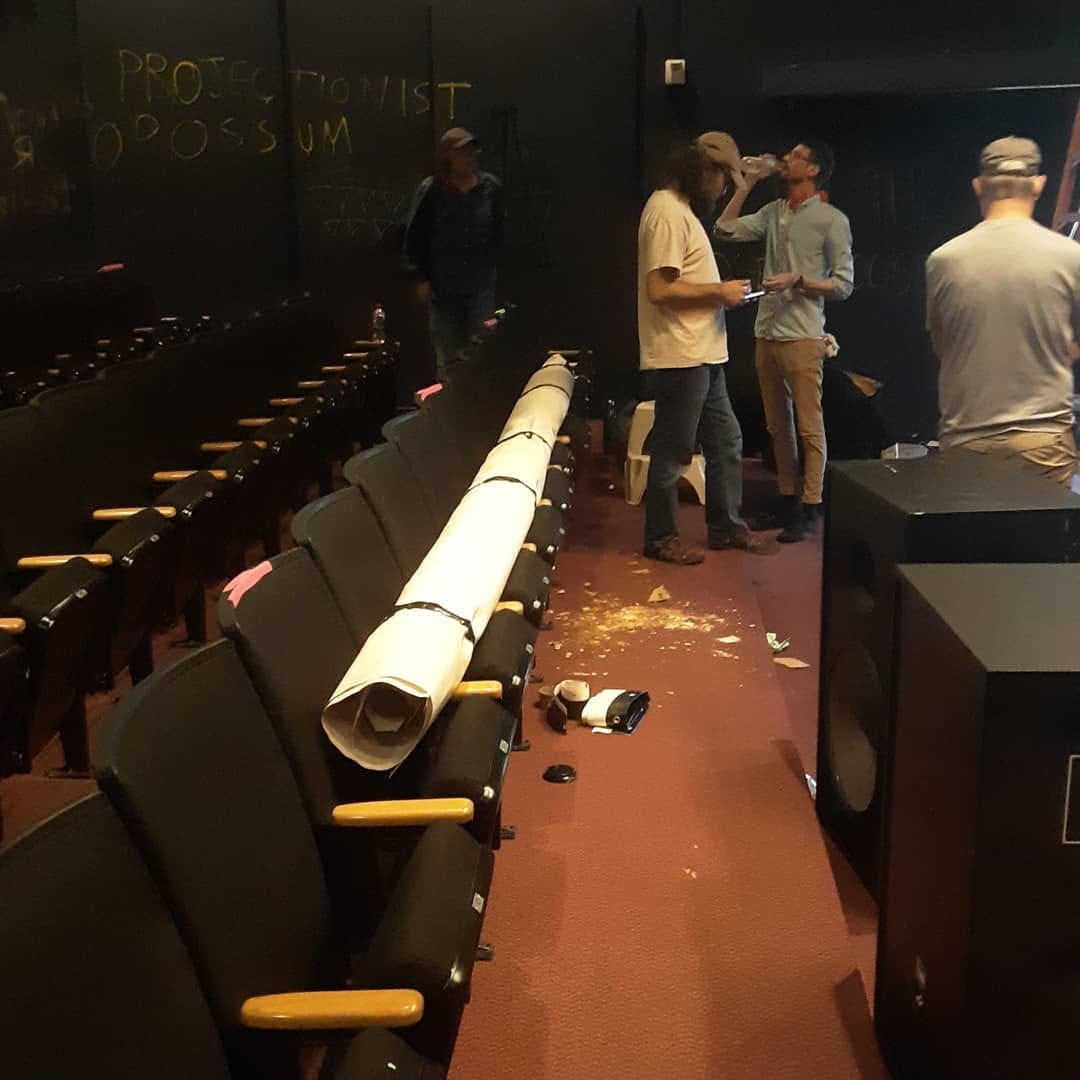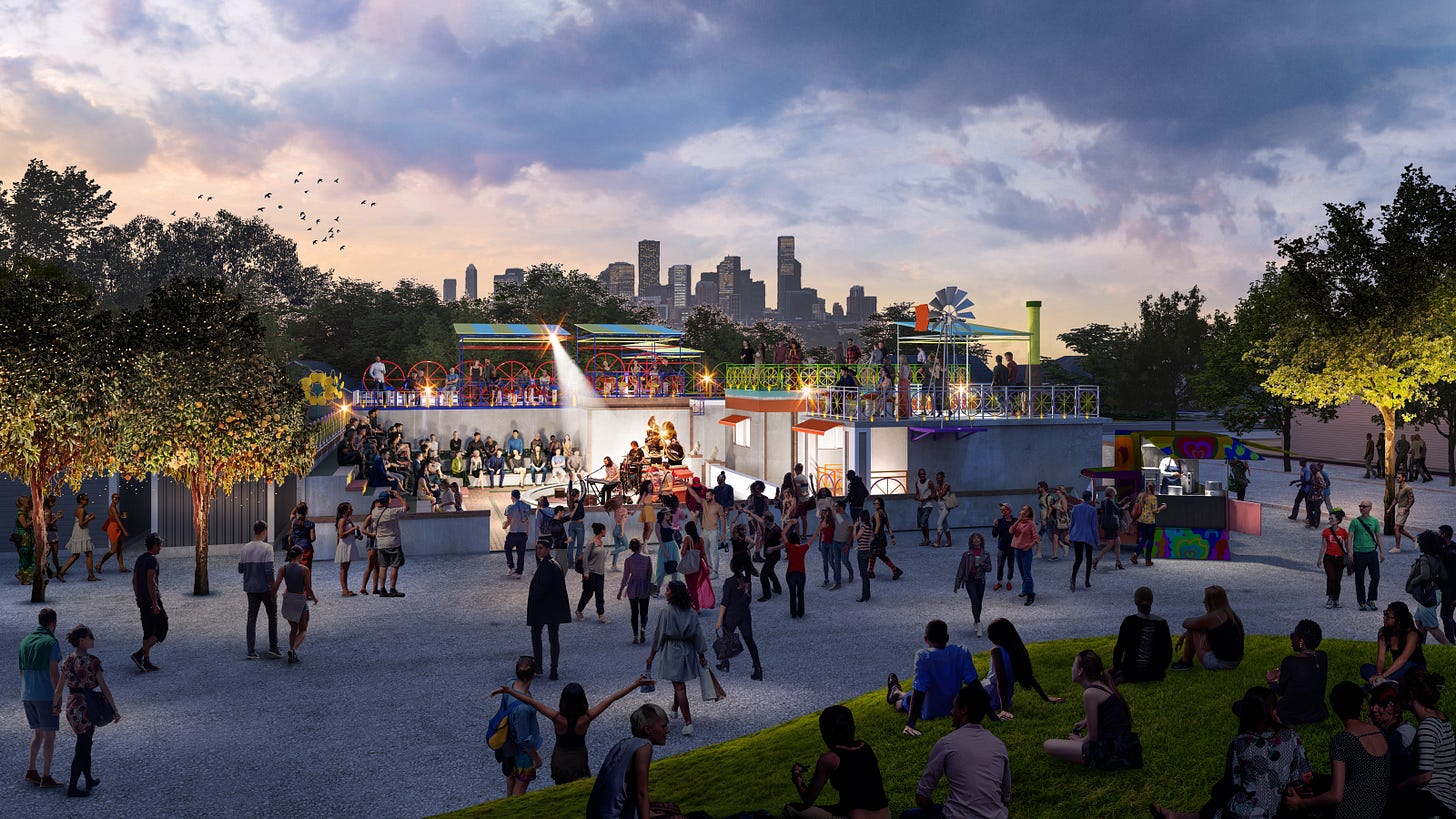Rice University Art Department and The Orange Show to Expand
Massive New Building Projects are on the Drawing Board
The Nancy and Rich Kinder Building opened a year ago. This was a major expansion of the Museum of Fine Arts campus. The space it occupies used to be a parking lot operated jointly by the Museum and by First Presbyterian Church. The MFAH long coveted that little piece of land, since they couldn’t really expand without it. So they bought land on the north side of the church decades ago. Eventually they traded the parking lot for some of the land north of the church. The Kinder building is the result of a decades long chess game played by the MFAH. That’s the kind of horizon you have when you have a multi-billion dollar endowment.
Two other Houston institutions have recently announced major capital expansions. First is Rice University. At Rice, the art department has always been a bit neglected. They had a flurry of new building when the Menils decided to get involved in the late 60s, which lead to the construction of Sewall Hall (which housed the art and art history department) and the Media Center and the Rice Museum. These were two metal-clad buildings isolated on the south side of campus. The museum ceased to be a museum in the 1980s, and the Media Center continued to be a vital part of the art department until earlier this year. Peter Lucas wrote an exceptional history of the Media Center on the occasion of its 50th anniversary, and I was there on it’s last day of being open to the public which I wrote about for Glasstire.
After this flurry of building, the art department puttered along for 50 years without much change. In 2017, a new arts building was built on campus, the Moody Center for the Arts. This large building with galleries, a theater, classrooms and a well-equipped workshop is, for some reason, not run by the art department. To be honest, I don’t understand its relationship to the rest of Rice University. It’s an art building that neither the art department nor art history department have any control over. (And the building, which they are so proud of, is fugly.)
The Moody Center was built right next door to the Media Center, which seems like an ridiculous duplication of effort—two important art buildings right next to one-another, somewhat duplicating functions, but run by separate parts of the university. But the Media Center’s days were numbered. It was never meant as a permanent building, and by 2020, the administration decided to tear it down. But not before lining up a replacement. After fifty years, the south side of campus had been filled in. They weren’t going to slap up two metal sheds as they had done in 1970. They hired an architect to devise a brand new art building.
This is a rendering of the new Susan and Fayez Sarofim Hall designed by Diller Scofidio + Renfro. Its footprint is quite large—it covers the area of the Media Center and the old Rice Museum, and then some. What is not obvious from this illustration is that it is actually two buildings with a driveway running between them. The driveway will be another entrance to the campus from University Drive. The fact that there is already a major entrance from University Drive right in front of the new building makes this second entrance seem utterly superfluous. What I’ve heard is that they’ve raised the money needed for one of the two buildings and will try to raise the rest as the first building is constructed, but this a rumor. It makes more sense than the decision to add an completely redundant entrance one block east of the already existing entrance at the corner of University and Stockton. The dean of Humanities offered this anodyne statement:
“This design opens the Rice campus to the city of Houston in an amazing new way,” said Dean of Humanities Kathleen Canning. “What also makes it really exciting is that this is a building that is not meant to encapsulate and contain the arts as they are today; this is a building that will foster open, flexible spaces for the arts of tomorrow.”
That said, if this building lives up to the admittedly idealized renderings, it will be quite impressive.
I wonder if this tree in the rendering is the same one that Andy Warhol planted in front of the Rice Museum in Rice Museum when it opened. It would be cool if it were, but it does mean building around it. I think art students gathering in the courtyard would appreciate the presence of a tree planted by Andy Warhol.
While I still don’t see why Sarofim Hall and the Moody Center will exist side by side, I do look forward to visual art getting a new permanent home on Rice University campus, where the discipline can be ignored for another 50 years.
When they were stripping the Media Center of all its recyclable bits, Pete Gershon, the new curator of the Orange Show, was there. His mission: taking the movie screen from the Media Center for the Orange Show.
The Orange Show has been going through some changes. The Orange Show has done some great things in the past few years, including the construction of Smither Park. But despite all this, they have been seen as a kind of footnote to Houston’s art community. They decided that needed to change. They hired a new executive director, Tommy Ralph Pace, and now have ambitious expansion plans.
This is an aerial rendering of the expansion plans by architectural firm Rogers Partners. The brightly lit building in the foreground is the original Orange Show, and directly to its right is Smither Park. The large building behind the Orange Show is a former pallet warehouse (where they hosted the Houston Zine Festival a few weeks ago), which according to their press release, will be transformed “into a world-class, flexible performance and exhibition space which will offer extensive possibilities for exhibitions, programs, and offices as well as a comprehensive visionary art library and archive, and spaces for education and events.”
It’s a big building, but that is a lot to ask for one structure.
When I saw these photos, my first thought was, how would the Orange Show pay for this? Rice (like the Museum of Fine Arts) has a huge endowment. If they wanted to, they could just write a check for their new art complex. Not so with the Orange Show. A quick look at the Orange Show’s 990 returns from the past few years shows annual revenue for the past few years of less than two miliion a year. And when you subtract out their operating expenses, that is not a lot of money.
To make this work, the Orange Show will need to launch a major capital campaign.
They need to do stuff like this. Golf tournements are kind of thing they probably teach you the first week of Nonprofit Development 101. You have to find ways to get rich people to open their wallets. And it never stops.
I love the Orange Show, but I recall a conversation with Jack Massing where he told me that he hoped that the Orange Show could be made relevant to the art community in Houston in a way that it really hasn’t been for a long time. I think they are on the right path here. The question is, can they do it? Can this smallish arts organization accomplish an expansion this big? They not only have to pay for a new building, but the operational costs of maintaining it and the salaries of the new employees they will have to hire. And more important, they will have to devise uses for all these new buildings that help to fulfill the mission of the Orange Show Foundation while being relevant to Houston and its arts community. I haven’t met Tommy Ralph Pace yet, but I know Pete Gershon has the vision needed to make it work.
[Please consider supporting my work by becoming a patron, and you can also support my work by patronizing my online store. And one more way to support what I do here is to buy books through my bookstore. ]











